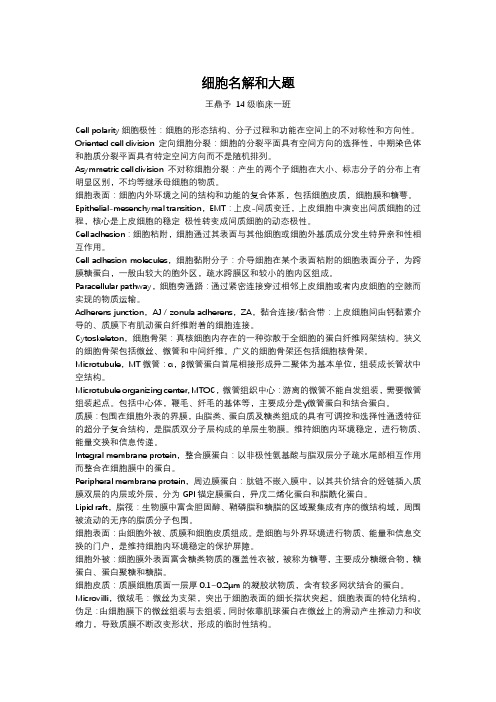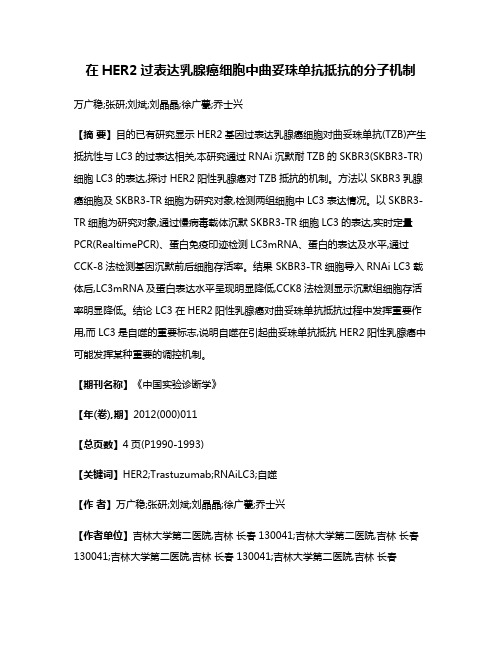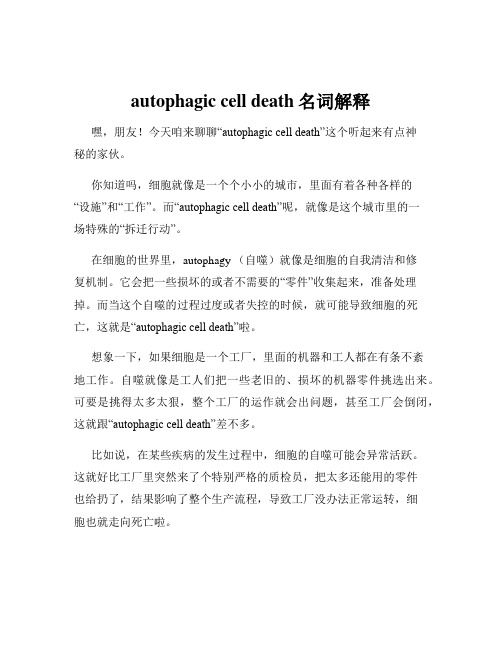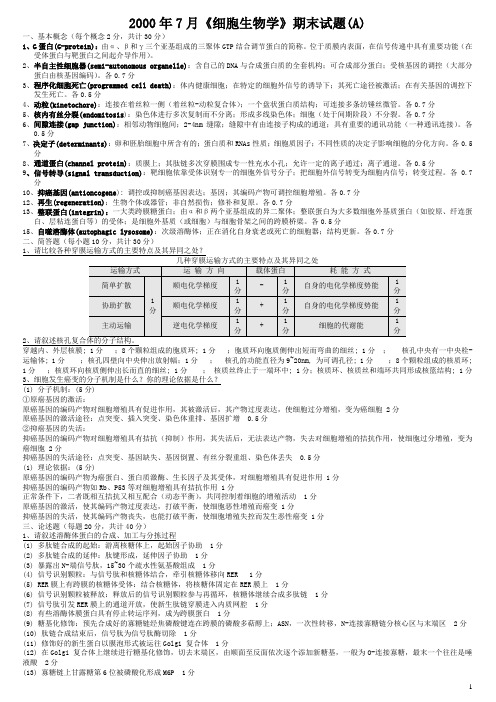Autophagic Cell Death and Cancer 细胞凋亡和癌症
细胞生物学名词解释和大题整理--北医本科

细胞名解和大题王鼎予14级临床一班Cell polarity细胞极性:细胞的形态结构、分子过程和功能在空间上的不对称性和方向性。
Oriented cell division 定向细胞分裂:细胞的分裂平面具有空间方向的选择性,中期染色体和胞质分裂平面具有特定空间方向而不是随机排列。
Asymmetric cell division 不对称细胞分裂:产生的两个子细胞在大小、标志分子的分布上有明显区别,不均等继承母细胞的物质。
细胞表面:细胞内外环境之间的结构和功能的复合体系,包括细胞皮质,细胞膜和糖萼。
Epithelial-mesenchymal transition,EMT:上皮-间质变迁,上皮细胞中演变出间质细胞的过程,核心是上皮细胞的稳定极性转变成间质细胞的动态极性。
Cell adhesion:细胞粘附,细胞通过其表面与其他细胞或细胞外基质成分发生特异亲和性相互作用。
Cell adhesion molecules,细胞黏附分子:介导细胞在某个表面粘附的细胞表面分子,为跨膜糖蛋白,一般由较大的胞外区,疏水跨膜区和较小的胞内区组成。
Paracellular pathway,细胞旁通路:通过紧密连接穿过相邻上皮细胞或者内皮细胞的空隙而实现的物质运输。
Adherens junction,AJ / zonula adherens,ZA,黏合连接/黏合带:上皮细胞间由钙黏素介导的、质膜下有肌动蛋白纤维附着的细胞连接。
Cytoskeleton,细胞骨架:真核细胞内存在的一种弥散于全细胞的蛋白纤维网架结构。
狭义的细胞骨架包括微丝、微管和中间纤维。
广义的细胞骨架还包括细胞核骨架。
Microtubule,MT微管:α,β微管蛋白首尾相接形成异二聚体为基本单位,组装成长管状中空结构。
Microtubule organizing center, MTOC,微管组织中心:游离的微管不能自发组装,需要微管组装起点。
包括中心体,鞭毛、纤毛的基体等,主要成分是γ微管蛋白和结合蛋白。
在HER2过表达乳腺癌细胞中曲妥珠单抗抵抗的分子机制

在HER2过表达乳腺癌细胞中曲妥珠单抗抵抗的分子机制万广稳;张研;刘斌;刘晶晶;徐广甍;乔士兴【摘要】目的已有研究显示HER2基因过表达乳腺癌细胞对曲妥珠单抗(TZB)产生抵抗性与LC3的过表达相关,本研究通过RNAi沉默耐TZB的SKBR3(SKBR3-TR)细胞LC3的表达,探讨HER2阳性乳腺癌对TZB抵抗的机制。
方法以SKBR3乳腺癌细胞及SKBR3-TR细胞为研究对象,检测两组细胞中LC3表达情况。
以SKBR3-TR细胞为研究对象,通过慢病毒载体沉默SKBR3-TR细胞LC3的表达,实时定量PCR(RealtimePCR)、蛋白免疫印迹检测LC3mRNA、蛋白的表达及水平,通过CCK-8法检测基因沉默前后细胞存活率。
结果 SKBR3-TR细胞导入RNAi LC3载体后,LC3mRNA及蛋白表达水平呈现明显降低,CCK8法检测显示沉默组细胞存活率明显降低。
结论 LC3在HER2阳性乳腺癌对曲妥珠单抗抵抗过程中发挥重要作用,而LC3是自噬的重要标志,说明自噬在引起曲妥珠单抗抵抗HER2阳性乳腺癌中可能发挥某种重要的调控机制。
【期刊名称】《中国实验诊断学》【年(卷),期】2012(000)011【总页数】4页(P1990-1993)【关键词】HER2;Trastuzumab;RNAiLC3;自噬【作者】万广稳;张研;刘斌;刘晶晶;徐广甍;乔士兴【作者单位】吉林大学第二医院,吉林长春130041;吉林大学第二医院,吉林长春130041;吉林大学第二医院,吉林长春130041;吉林大学第二医院,吉林长春130041;吉林大学第二医院,吉林长春130041;吉林大学第二医院,吉林长春130041【正文语种】中文【中图分类】R737.9乳腺癌是严重影响妇女身心健康甚至危及生命的最常见的恶性肿瘤之一,随着环境、饮食及生活习惯等的改变,我国乳腺癌的发病率呈逐年上升趋势。
研究结果显示在25%-30%的乳腺癌中存在HER-2基因异常扩增及其蛋白的过度表达[1,2]。
autophagic cell death名词解释

autophagic cell death名词解释嘿,朋友!今天咱来聊聊“autophagic cell death”这个听起来有点神秘的家伙。
你知道吗,细胞就像是一个个小小的城市,里面有着各种各样的“设施”和“工作”。
而“autophagic cell death”呢,就像是这个城市里的一场特殊的“拆迁行动”。
在细胞的世界里,autophagy (自噬)就像是细胞的自我清洁和修复机制。
它会把一些损坏的或者不需要的“零件”收集起来,准备处理掉。
而当这个自噬的过程过度或者失控的时候,就可能导致细胞的死亡,这就是“autophagic cell death”啦。
想象一下,如果细胞是一个工厂,里面的机器和工人都在有条不紊地工作。
自噬就像是工人们把一些老旧的、损坏的机器零件挑选出来。
可要是挑得太多太狠,整个工厂的运作就会出问题,甚至工厂会倒闭,这就跟“autophagic cell death”差不多。
比如说,在某些疾病的发生过程中,细胞的自噬可能会异常活跃。
这就好比工厂里突然来了个特别严格的质检员,把太多还能用的零件也给扔了,结果影响了整个生产流程,导致工厂没办法正常运转,细胞也就走向死亡啦。
再打个比方,细胞好比是一个大家庭,自噬就是家里的大扫除。
正常的大扫除能让家里整洁有序,但要是把家里有用的东西也都当垃圾扔了,那这个家不就乱套了吗?这就是“autophagic cell death”的情况。
研究“autophagic cell death”对于理解很多生理和病理过程都非常重要。
比如说癌症,有些癌细胞可能会利用自噬来逃避治疗,导致治疗效果不佳。
这难道不可怕吗?所以啊,搞清楚“autophagic cell death”的机制,就像是掌握了细胞世界的一把神秘钥匙,可以帮助我们更好地治疗疾病,保护我们的健康。
这难道不值得我们去深入探索吗?总之,“autophagic cell death”是细胞世界里一个复杂而又关键的现象,我们对它的了解还只是冰山一角,还有更多的奥秘等待着我们去揭开呢!。
细胞自噬的概念和意义

细胞自噬的概念和意义关键词:细胞溶酶体化学标准物质北京标准物质网一、细胞自噬的概念细胞自噬(autophagy)是存在于真核生物中一种高度保守的蛋白质或细胞器的降解过程。
该过程中一些损坏的蛋白质或细胞器等胞质成分被双层膜结构的自噬小泡包裹,并最终运送至溶酶体(动物)或液泡(酵母和植物)中进行降解,降解产生的氨基酸和其他一些小分子物质可被再利用或产生能量,从而维持细胞基本的生命活动。
根据底物进入溶酶体途径的不同,细胞自噬分为三种类型:大自噬(macroautophagy)、小自噬(microautophagy)和分子伴侣介导的白噬(chaperone-mediated autophagy,CMA)。
通常所讲的自噬指的是大自噬。
二、细胞自噬的意义细胞自噬与细胞凋亡、细胞衰老一样,是十分重要的生物学现象,其参与调节细胞物质的合成、降解和重新利用之间的代谢平衡,影响到生物生命过程的方方面面。
自噬具有多种生理功能包括耐受饥饿,清除细胞内折叠异常的蛋白质或蛋白质聚合物、受损或多余的细胞器,促进发育和分化,延长寿命,清除微生物等。
细胞在正常生长条件下能进行较低水平的自噬,即基础自噬,以维持生理状态下机体内环境的稳态。
自噬既是细胞的一种正常生理活动,也可在细胞遭受各种细胞外或细胞内刺激(缺氧,缺营养,接触某些化学物质,某些微生物入侵细胞内,细胞器损伤,细胞内异常蛋白的过量累积等)时作为应激反应而被激活,起到保护细胞存活的作用。
例如,在处于饥饿条件下,细胞通过自噬降解过程,以提供氨基酸以产生新的蛋白质,为线粒体提供原料以产生能量来应对饥饿求得生存。
但是,过度活跃的自噬活动也可以引起细胞死亡,即“白噬性细胞死亡(autophagic cell death)”,也称为Ⅱ型程序性细胞死亡。
自噬现象广泛存在于真核细胞的病理生理过程中,包括发育、衰老、神经退行性疾病、癌症和一些传染病等。
自噬与人类多种疾病的发生发展存在着密切的关系。
肿瘤的生物学行为——临床肿瘤学概论

R. Timothy (Tim) Hunt
Sir Paul M. Nurse
2001年10月8日美国人Leland Hartwell、英国人Paul Nurse、Timothy Hunt 因对细胞周期调控机理的研究而荣获诺贝尔生理医学奖
• 驱动机制:负责细胞生长和增殖,促进细 胞完成细胞周期
–CDK,细胞周期蛋白,癌蛋白
Hanahan D et al. Hallmarkers of cancer. The next generation. Cell 2011;144:646-674
第一节 肿瘤细胞生长特性
细胞周期 细胞死亡 细胞分化
细胞周期与肿瘤
一. 细胞周期与肿瘤
细胞周期(cell cycle)
细胞从一次分裂结束到下一次分裂完成 所经历的整个过程。
2009年细胞命名委员会(Nomenclature Committee on Cell Death)建议,符合下 面任何一条分子学或形态学标准即可定义 为“细胞死亡”:
• 丧失细胞膜完整性,体外活性染料能够渗入 • 细胞彻底碎裂,成为离散的小体 • 在体内细胞残骸被邻近细胞吞噬
细胞死亡的形式
根据形态特征分为: • 细胞凋亡(apoptosis) • 细胞坏死(necrosis) • 自噬性细胞死亡(autophagic cell
• 监控机制:负责细胞损伤或接受生长阻滞 信号时,使细胞周期停滞,启动细胞修复 机制,确保DNA复制和分裂完成的准确性
–CDKI,抑癌蛋白
• 细胞周期检查点
–G1/S,S/G2,G2/M
驱动机制
监控机制
细胞周期蛋白 (cyclins)
-调控CDKs活性的最基本成分 如:Cyclin A, B, D, E
细胞自噬的生理学和病理学

细胞自噬的生理学和病理学细胞自噬(Autophagy)是一种重要的细胞代谢过程,能够降解和回收细胞内的有害物质和老化或损伤的细胞器等。
细胞自噬在细胞发育、代谢和免疫功能等方面都扮演着重要角色。
在正常生理状态下,细胞自噬发挥着促进细胞代谢的作用,维护细胞的稳态。
但是在某些病理状态下,细胞自噬也可能会参与到细胞死亡和肿瘤发生等过程中。
一、细胞自噬的基本过程细胞自噬的基本过程可以分为三个步骤:对损伤、有害的物质和细胞器的包裹、溶解和消化。
1、包裹囊泡(Autophagosome)是细胞自噬最重要的结构,它会把具有自噬鉴别标识的细胞器和其他物质包裹在内,生成一个包裹物。
这个过程需要一些酶类和蛋白质的参与,例如Uber1、LC3、Atg5和Atg12等。
2、溶解之后,包裹继续往细胞质和溶液池中移动,合并后形成自噬体(Autolysosome),里面有水解酶和酸性蛋白。
这些酶和蛋白会在自噬体内运作,将包裹细胞器和其他物质分解为营养物质和废物等。
3、消化分解后产生的物质可以通过自噬体内的通道回到细胞质供能或修复细胞器等。
二、细胞自噬的生理学1、维持细胞代谢平衡细胞自噬是细胞自身对于外界或内部环境发生变化而产生的应对过程。
在环境压力或资源不足时,通过细胞自噬的过程可以同时降解和回收细胞内的废物和营养成分,来维持细胞内的代谢平衡,让细胞进一步适应外界环境。
在一些正常的生理活动过程中,例如饥饿状态、发育、起源、受精、怀孕和肺部侵染等,细胞自噬也会被激活来维持细胞代谢平衡。
同时,也发现一些人类和非人类的疾病患者会发生细胞自噬失调等现象,例如神经退行性疾病、肌肉萎缩、癌症和感染等。
2、细胞自噬能够引发细胞生长与死亡细胞自噬虽然在细胞代谢和维持细胞韧性方面发挥着作用,但是也在细胞生长和死亡等方面扮演着重要的角色。
在肿瘤生长的过程中,细胞自噬可能会激活细胞的免疫保护能力,并通过基因变异来增殖。
但是,当细胞自噬过程不完整或失调时,会有一些生长因子和产生影响并激活肿瘤细胞生长和转移到其他器官的相关基因。
2000年《细胞生物学》期末试卷A参考答案

2000年7月《细胞生物学》期末试题(A)一、基本概念(每个概念2分,共计30分)1、G蛋白(G-protein):由α、β和γ三个亚基组成的三聚体GTP 结合调节蛋白的简称。
位于质膜内表面,在信号传递中具有重要功能(在受体蛋白与靶蛋白之间起介导作用)。
2、半自主性细胞器(semi-autonomous organelle):含自己的DNA与合成蛋白质的全套机构;可合成部分蛋白;受核基因的调控(大部分蛋白由核基因编码)。
各0.7分3、程序化细胞死亡(programmed cell death):体内健康细胞;在特定的细胞外信号的诱导下;其死亡途径被激活;在有关基因的调控下发生死亡。
各0.5分4、动粒(kinetochore):连接在着丝粒一侧(着丝粒-动粒复合体);一个盘状蛋白质结构;可连接多条纺锤丝微管。
各0.7分5、核内有丝分裂(endomitosis):染色体进行多次复制而不分离;形成多线染色体;细胞(处于间期阶段)不分裂。
各0.7分6、间隙连接(gap junction):相邻动物细胞间;2-4nm缝隙;缝隙中有由连接子构成的通道;具有重要的通讯功能(一种通讯连接)。
各0.5分7、决定子(determinants):卵和胚胎细胞中所含有的;蛋白质和RNAs性质;细胞质因子;不同性质的决定子影响细胞的分化方向。
各0.5分8、通道蛋白(channel protein):质膜上;其肽链多次穿膜围成专一性充水小孔;允许一定的离子通过;离子通道。
各0.5分9、信号转导(signal transduction):靶细胞依靠受体识别专一的细胞外信号分子;把细胞外信号转变为细胞内信号;转变过程。
各0.7分10、抑癌基因(antioncogene): 调控或抑制癌基因表达;基因;其编码产物可调控细胞增殖。
各0.7分12、再生(regeneration):生物个体或器管;非自然损伤;修补和复原。
各0.7分13、整联蛋白(integrin):一大类跨膜糖蛋白;由α和β两个亚基组成的异二聚体;整联蛋白为大多数细胞外基质蛋白(如胶原、纤连蛋白、层粘连蛋白等)的受体;是细胞外基质(或细胞)与细胞骨架之间的跨膜桥梁。
细胞自噬与疾病

(Autophage and Disease)
中南大学基础医学院 病理生理学教研室
一、定义
细胞自噬(autophagy or autophagocytosis):
是指细胞内自身胞浆蛋白或细胞器被包裹形 成囊泡,并在溶酶体中降解的过程。
细胞内自身成分降解的主要途径
1、蛋白酶体途径(Ubiquitin-proteasome system, UPS) : 降解细胞内短寿(short-lived)、多聚泛素化(ubiquitination) 的蛋白质。 原核生物:通过19S的蛋白酶体能识别靶蛋白的特定氨 基酸序列并将其降解。 真核生物:则是通过26S的蛋白酶体降解蛋白质。 2、内吞途径:将跨膜蛋白运送到溶酶体降解。 3、细胞自噬途径:而长寿蛋白(long-lived protein)、蛋 白聚集物及膜包被的细胞器是通过细胞自噬的方式在 溶酶体降解。
Macroautophagy↑,清除堆集的变性蛋白复合体;
疾病失代偿期: UPS↓和CMA↓
Macroautophagy↓
异常蛋白堆集 自噬小泡累积
有研究显示,使用促进细胞自噬的药物,如Rapamycin(雷 帕霉素)可改善帕金森病(Parkinson’s disease, PD)、阿尔茨 海默病(Alzheimer’s disease, AD)等疾病的病情。
第三步:底物蛋白被溶酶体酶降解。
三、细胞自噬的生物学意义
1、应激功能
细胞自噬是细胞在饥饿条件下的一种存活机制。 如:营养缺乏时,细胞自噬增强,使非关键成分降解,释 放出营养成分,以保证关键过程的继续。
2、防御功能
在细胞受到致病微生物感染时,细胞自噬起一定的积极防 御作用。
如:单纯疱疹病毒感染时,在自噬囊泡中发现有病毒颗粒。
- 1、下载文档前请自行甄别文档内容的完整性,平台不提供额外的编辑、内容补充、找答案等附加服务。
- 2、"仅部分预览"的文档,不可在线预览部分如存在完整性等问题,可反馈申请退款(可完整预览的文档不适用该条件!)。
- 3、如文档侵犯您的权益,请联系客服反馈,我们会尽快为您处理(人工客服工作时间:9:00-18:30)。
Int. J. Mol. Sci.2014, 15, 3145-3153; doi:10.3390/ijms15023145International Journal ofMolecular SciencesISSN 1422-0067/journal/ijms ReviewAutophagic Cell Death and CancerShigeomi Shimizu *, Tatsushi Yoshida, Masatsune Tsujioka and Satoko ArakawaDepartment of Pathological Cell Biology, Medical Research Institute,Tokyo Medical and Dental University, 1-5-45 Yushima, Bunkyo-ku, Tokyo 113-8510, Japan;E-Mails: yoshida.pcb@mri.tmd.ac.jp (T.Y.); tsujioka.pcb@mri.tmd.ac.jp (M.T.);arako.pcb@mri.tmd.ac.jp (S.A.)*Author to whom correspondence should be addressed; E-Mail: shimizu.pcb@mri.tmd.ac.jp;Tel.: +81-3-5803-4692; Fax: +81-3-5803-4821.Received: 6 January 2014; in revised form: 10 February 2014 / Accepted: 13 February 2014 / Published: 21 February 2014Abstract: Programmed cell death (PCD) is a crucial process required for the normaldevelopment and physiology of metazoans. The three major mechanisms that induce PCDare called type I (apoptosis), type II (autophagic cell death), and type III (necrotic celldeath). Dysfunctional PCD leads to diseases such as cancer and neurodegeneration.Although apoptosis is the most common form of PCD, recent studies have providedevidence that there are other forms of cell death. One of such cell death is autophagic celldeath, which occurs via the activation of autophagy. The present review summarizes recentknowledge about autophagic cell death and discusses the relationship with tumorigenesis.Keywords: programmed cell death; autophagic cell death; Atg5-independent autophagy;Beclin1; tumorigenesis; c-Jun N-terminal kinase (JNK)1. IntroductionApoptosis is a form of programmed cell death (PCD), and its molecular basis is well understood. However, PCD is mediated by other mechanisms as well. For example, morphological analyses of embryogenesis revealed three types of PCD as follows: apoptosis (type I cell death), autophagic programmed cell death (type II cell death), and necrotic programmed cell death (type III cell death)[1,2]. This review focuses on recent experimental evidence that illuminates the mechanisms of autophagic cell death and its role in tumorigenesis.2. ApoptosisApoptosis is the most crucial form of cell death in mammals, and its molecular signaling pathway is well defined [3]. Mammalian cells possess two apoptotic signaling pathways, which are known as the intrinsic and extrinsic pathways. In the intrinsic pathway, most apoptotic stimuli transmit death signals to the mitochondria and increase the permeability of the outer mitochondrial membrane, which leads to the release of apoptogenic proteins, such as cytochrome c, Smac, and Omi, into the cytoplasm from the mitochondria. After its release, cytochrome c associates with apoptotic protease activating factor-1 (Apaf-1), which activates the caspase cascade to execute apoptotic cell death. Smac and Omi accelerate caspase activation through inhibition of Inhibition of Apoptosis (IAP) family members that function as endogenous caspase inhibitors. Apoptosis-associated mitochondrial membrane permeability is primarily controlled by Bcl-2 family members, which include three subgroups: anti-apoptotic proteins (Bcl-2, Bcl-x L, and Mcl-1); multi-domain pro-apoptotic proteins (Bak and Bax); and proteins with only BH3 domain (Bid, Bim, Bik, Bad, Noxa, and Puma). Among them, Bak and Bax play an essential role in the release of apoptogenic proteins (Figure 1). In the extrinsic pathway, engagement of death receptors, such as Fas and tumor necrosis factor-α receptor, directly activates caspase-8 that activates downstream caspases, such as caspase-3 or caspase-7, which induce apoptotic cell death.Figure 1. Molecular mechanism of apoptosis and autophagic cell death. An increase in thepermeability of the outer mitochondrial membrane is crucial for apoptosis to occur and isregulated by multidomain pro-apoptotic members of the Bcl-2 family (Bax and Bak),resulting in the release of cytochrome c into the cytoplasm. Then, cytochrome c associateswith apoptotic protease activating factor-1 (Apaf-1), which activates the caspase cascade toexecute apoptotic cell death. Apoptosis-associated mitochondrial membrane permeabilityis primarily controlled by Bcl-2 family members. When apoptosis is blocked, variousapoptotic stimuli activate autophagy and c-Jun N-terminal kinase (JNK), resulting in theinduction of autophagic cell death.Until 10 years ago, evidence indicated that physiological and pathological cell death was primarily mediated through apoptosis. However, detailed analysis of Bax/Bak double-knockout mice in which the intrinsic apoptotic pathway is totally inhibited, indicated that PCD largely proceeds normally, even in mice resistant to apoptosis [4,5]. These findings focused the attention of researchers on identifying other pathways of PCD, which led to the discovery that autophagy also mediates PCD as well as other physiological and pathological events.3. AutophagyAutophagy is a catabolic process that digests cellular contents within lysosomes. Autophagy is a low-level constitutive function that is accelerated by a variety of cellular stressors such as nutrient starvation, DNA damage, and organelle damage. Autophagy serves as a protective mechanism that facilitates the degradation of superfluous or damaged cellular constituents, although hyperactivation of autophagy can lead to cell death.Evidence supports the conclusion that autophagy represents the major pathway for degrading cytoplasmic proteins and organelles [6]. In this multistep process, cytoplasm and damaged organelles are sequestered inside isolation membranes that eventually mature into double-membrane structures called autophagosomes that subsequently fuse with lysosomes to form autolysosomes, which digest the sequestered components. The molecular basis of autophagy was first studied in autophagy-defective mutant yeasts [6]. Subsequent identification of vertebrate homologs of yeast autophagy proteins greatly expanded our understanding of the molecular mechanisms of autophagy.Autophagy is driven by more than 30 well-conserved proteins (Atgs), from yeasts to mammals [7]. Atg1 (also called Unc51-like kinase 1 (Ulk1)) is a serine/threonine kinase essential for the initiation of autophagy [8]. Autophagy is also regulated by phosphatidylinositol 3-kinase (PI3K) type III, which is a component of a multi-protein complex that includes Atg6 (Beclin1). PI3K promotes invagination of the membrane at domains rich in phosphatidylinositol-3-phosphate (PI3P), which are called omegasomes, to initiate generation of the isolation membrane [9]. Subsequent expansion and closure of isolation membranes are mediated by two ubiquitin-like conjugation pathways as follows: the Atg5–Atg12 pathway and the microtubule-associated protein 1 light chain 3 (LC3) pathway [7]. Ubiquitin-like conjugation of phosphatidylethanolamine (PE) to LC3 facilitates translocation of LC3 from the cytosol to sites of origin of the autophagic membrane. Moreover, the localization of LC3-PE in autophagic membranes makes this complex a reliable marker of autophagy. The suppression of autophagy in Atg5-deficient cells indicates the essential role of the Atg5–Atg12 pathway in autophagy (Figure 2).Although Atg5 function is crucial for autophagy, we identified an Atg5-independent autophagic pathway, which is induced when cells are severely stressed, for example, by DNA damage but not by nutrient deprivation. The morphology of Atg5-independent autophagic structures is indistinguishable from those that form during Atg5-dependent autophagy, i.e., isolation membrane, autophagosomes, and autolysosomes [10]. We call the Atg5-independent pathway alternative macroautophagy, which is driven by Ulk1 and phosphoinositol 3-kinase complexes at the initiation steps. These molecules function at the initiation of conventional autophagy as well. In contrast, this pathway is not mediated by other components, such as Atg9 and proteins of the ubiquitin-like protein conjugation system(Atg5, Atg7, and LC3), that function to extend conventional autophagic membranes (Figure 2). Because alternative macroautophagy requires the extension of autophagic membranes, several molecules may serve to mediate this function. One such molecule is Rab9, a protein involved in membrane trafficking. Experiments using dominant negative mutants and gene silencing found that Rab9 is essential for membrane expansion and fusion in alternative macroautophagy.Figure 2. Hypothetical model of macroautophagy. There are at least two modes ofmacroautophagy, i.e.,conventional and alternative macroautophagy. Conventionalmacroautophagy depends on Atg5 and Atg7, is associated with light chain 3 (LC3)modification and may originate from Endoplasmic reticulum (ER)-mitochondria contactmembrane. In contrast, alternative macroautophagy occurs independent of Atg5 or Atg7expression and LC3 modification. The generation of autophagic vacuoles in this type ofmacroautophagy may originate from Golgi membrane and late endosomes (LE) in aRab9-dependent manner. Although both these processes lead to bulk degradation ofdamaged proteins or organelles by generating autolysosomes, they seem to be activated bydifferent stimuli, in different cell types and have different physiological roles.Alternative macroautophagy is not an atypical form of autophagy because it occurs in a wide variety of cells, including embryonic fibroblasts and thymocytes as well as in various tissues such as that of the heart, brain, and liver. It is activated by a variety of stressors but not by rapamycin. Erythrocyte maturation is a representative example of physiological events that involve alternative macroautophagy. Enucleation and the clearance of mitochondria occur during the transition of erythroblasts into reticulocytes, which occurs prior to terminal maturation into erythrocytes, with macroautophagy functioning in the latter process. In contrast, erythrocyte maturation usually occurs in Atg5-deficient embryos [10], indicating that conventional macroautophagy does not eliminate mitochondria from erythrocytes.Moreover, ultrastructural analysis has demonstrated that autophagic structures in reticulocytes equivalently engulf and digest mitochondria in wild-type and Atg5-deficient embryos. Furthermore,mitochondrial clearance from erythrocytes is significantly altered in Ulk1-deficient embryos in the absence of macroautophagy [11]. Therefore, these data suggest that Ulk1-mediated alternative macroautophagy plays a crucial role in the elimination of mitochondria from erythrocytes. Ongoing research promises to provide a more detailed picture of the physiological and pathological relevance of alternative macroautophagy. In addition to alternative macroautophagy, previous reports have described a Beclin 1-independent type of autophagy [12]. Although conventional, alternative, and Beclin 1-independent macroautophagy generally leads to bulk degradation of cellular proteins, they may also be activated by various stimuli in different cell types and play different physiological roles. For a better understanding of macroautophagy, it is important to classify autophagy-related molecules according to the type of macroautophagy in which they are involved.4. Autophagic Cell DeathAlthough many autophagic cells are present in regions where cell death occurs, certain modes of cell death that are accompanied by protective autophagy are not called “autophagic cell death”. For example, a large number of autophagic cells are observed when cells are starved. However, autophagy prevents starvation-induced necrosis and does not induce cell death because the inhibition of autophagy accelerates, rather than inhibiting, cell death [13]. Therefore, we suggest using the term “autophagic cell death.” based on molecular and functional aspects, to indicate cell death mediated by autophagy. The term autophagic cell death should be used when cell death is suppressed by the inhibition of autophagy using chemical inhibitors (e.g., 3-methyl adenine and wortmannin) or genetic ablation (e.g., knockout or siRNA silencing of essential autophagy genes). If inhibiting autophagy does not prevent cell death, this process should not be called autophagic cell death.There is skepticism regarding the phenomenon of mammalian autophagic cell death because Atg5-deficient mice generally do not show any developmental defects [14]. However, as described earlier, mammalian cells are capable of performing two types of autophagy (Atg5-dependent and Atg5-independent) and their functions compensate each other. Thus, the absence of abnormalities in Atg5-deficient embryos does not necessarily indicate the absence of autophagic cell death. There are several distinct settings of autophagic cell death. First, caspase-independent, autophagy-dependent PCD occurs during mammalian embryogenesis. Second, autophagy may induce developmental cell death during regression of the salivary glands in Drosophila [15].Third, autophagy-mediated cell death is induced in apoptosis-resistant cells, particularly in the absence of the pro-apoptotic proteins Bax and Bak [16,17]. The latter situation should provide an excellent experimental system to investigate autophagic cell death, because the process can be observed at the cellular level.5. Molecular Mechanism of Autophagic Cell DeathBax/Bak-deficient cells do not undergo apoptosis after exposure to a variety of apoptotic stimuli, although these cells still die with numerous autophagic structures [16]. This type of cell death is inhibited by autophagy inhibitors or by silencing autophagy genes such as Atg5 and Atg6 [16]. Thus, Atg5-dependent autophagy is required for the death of Bax/Bak-deficient cells after exposure to apoptotic stimuli (Figure 2). Although we discovered Atg5-independent alternative autophagy, it is not involved in autophagic cell death of Bax/Bak-deficient cells. However, this does not necessarilyindicate that alternative autophagy in autophagic cell death is irrelevant. In other situations, alternative autophagy potentially induces autophagic cell death.Because activation of autophagy is necessary but not sufficient for autophagic cell death, it requires additional death signals. We recently discovered that c-Jun N-terminal kinase (JNK) generates such death signals [13]. When Bax/Bak-deficient cells were exposed to apoptotic stimuli, we found that autophagic cell death occurs simultaneously with increased levels of phosphorylated JNK. The essential role of phospho-JNK was confirmed by the addition of JNK inhibitors or the enforced expression of a dominant-negative (DN) JNK plasmid. Interestingly, neither the JNK inhibitor nor JNK-DN influence the extent of autophagy, suggesting that simultaneous activation of JNK and autophagy is required for autophagic cell death. Supporting this conclusion are findings that nutrient-starved cells possess large numbers of autophagic structures. However, because JNK was not activated in these cells, cell death was not caused by autophagy. Further, enforced expression of activated JNK in these cells rapidly induced autophagy-mediated cell death. Thus, we suggest that activation of autophagy and JNK is necessary when cells are committed to autophagic cell death (Figure 1).6. Cancer and Autophagic Cell DeathIt has been suggested that autophagic cell death participates in physiological and pathological events. Although a large body of evidence indicates that the inhibition of apoptosis is critical for tumorigenesis, elimination of cancer cells may also be mediated through autophagic cell death and there is evidence that decreased autophagic activity is related to tumorigenesis. For example, Beclin1 (Atg6) levels are lower in ovarian, breast, and prostate cancer because of monoallelic mutations [18]. Furthermore, mice heterozygous for the beclin1 gene have a higher risk for tumorigenesis [18,19]. Therefore, these findings provide compelling evidence that inhibition of Beclin1 expression contributes to the pathogenesis of cancer. Moreover, previous reports have shown that loss-of-function mutations of Atg5 and LC3 promote myeloma and glioblastoma, respectively [20,21], suggesting that failure of cells to undergo autophagy leads to tumor progression. Although autophagy plays a role in tumor suppression, it also promotes tumor cell growth by supplying nutrients under hypoxic conditions. Cancer cells require several nutrients to accelerate cell proliferation, and studies have shown that nutrient deprivation results in the impairment of tumor growth in some autophagy-deficient cancer cells [22]. Thus, these research findings suggest that autophagy plays dual roles in cancer and well as functions in a context-dependent manner.Several mechanisms have been proposed to explain the tumor suppressive function of autophagy: (1) accumulation of p62, a substrate of autophagy, leads to NF-κB activation [22]; (2) accumulation of p62 stabilize Nrf2, which imparts tumor cells with resistance to hypoxic stress [23]; (3) retention of damaged organelles, including mitochondria, increases the level of active oxygen species and increases the mutation rate; and (4) defective elimination of cancer cells due to the loss of autophagic cell death [13]. These mechanisms may be cell- and stimulus-type specific; however, we believe that it is reasonable to conclude that the failure of autophagic cell death is one of the most crucial mechanisms for tumorigenesis because autophagic cell death occurs in normal cells (e.g., fibroblasts or thymocytes) but not in most cancer cells. Furthermore, in some cancer cells, the magnitude of JNK activation, a crucial factor for autophagic cell death, is significantly lower compared with that in normal cells afterexposure to apoptotic stimuli [13]. In such cancer cells, JNK activity may not reach the threshold level required to induce autophagic cell death. This conclusion is supported by data showing that enforced expression of activated JNK in cancer cells induces autophagic cell death. Taken together, it is likely that insufficient activation of JNK followed by failure of autophagic cell death may induce uncontrolled growth of cells that ultimately acquire the malignant phenotype.7. Conclusions and Future ProspectsHere we describe the molecular mechanism and pathological role of autophagic cell death; however, the underlying mechanisms remain to be defined in detail. Moreover, the lack of molecular markers of autophagic cell death impedes research progress. Therefore, defining the biological roles of autophagic cell death will require a better understanding of the relevant molecular mechanisms of autophagic cell death, and the contribution of autophagic cell death to physiology and pathogenesis, particularly tumorigenesis.AcknowledgmentsThis review is written by the support in part by the Grant-in-Aid for Scientific Research on Innovative Areas, Grant-in-Aid for Scientific Research (S), Grant-in-Aid for challenging Exploratory Research from the Ministry of Education, Culture, Sports, Science and Technology (MEXT) of Japan, a grant for the Program for Promotion of Fundamental Studies in Health Sciences of the National Institute of Biomedical Innovation (NIBIO), and the Secom Science and Technology Foundation.Conflicts of InterestThe authors declare no conflict of interest.References1.Clarke, P.G. Developmental cell death: Morphological diversity and multiple mechanisms.Anat. Embryol. (Berl.)1990, 181, 195–213.2.Baehrecke, E.H. How death shapes life during development. Nat. Rev. Mol. Cell Biol.2002,3,779–787.3.Tsujimoto, Y. Cell death regulation by the Bcl-2 protein family in the mitochondria. J. Cell.Physiol.2003, 195, 158–167.4.Lindsten, T.; Ross, A.J.; King, A.; Zong, W.X.; Rathmell, J.C.; Shiels, H.A.; Ulrich, E.;Waymire, K.G.; Mahar, P.; Frauwirth, K.; et al. The combined functions of proapoptotic Bcl-2 family members bak and bax are essential for normal development of multiple tissues. Mol. Cell 2000, 6, 1389–1399.5.Wei, M.C.; Zong, W.X.; Cheng, E.H.; Lindsten, T.; Panoutsakopoulou, V.; Ross, A.J.; Roth, K.A.;MacGregor, G.R.; Thompson, C.B.; Korsmeyer, S.J. Proapoptotic BAX and BAK: A requisite gateway to mitochondrial dysfunction and death. Science2001, 292, 727–730.6.Nakatogawa, H.; Suzuki, K.; Kamada, Y.; Ohsumi, Y. Dynamics and diversity in autophagymechanisms: Lessons from yeast. Nat. Rev. Mol. Cell Biol. 2009, 10, 458–467.7.Mizushima, N.; Yoshimori, T.; Ohsumi, Y. The role of Atg proteins in autophagosome formation.Annu. Rev. Cell Dev. Biol.2011, 27, 107–132.8.Kabeya, Y.; Kamada, Y.; Baba, M.; Takikawa, H.; Sasaki, M.; Ohsumi, Y. Atg17 functions incooperation with Atg1 and Atg13 in yeast autophagy. Mol. Biol. Cell 2005, 16, 2544–2553.9.Axe, E.L.; Walker, S.A.; Manifava, M.; Chandra, P.; Roderick, H.L.; Habermann, A.; Griffiths, G.;Ktistakis, N.T. Autophagosome formation from membrane compartments enriched in phosphatidylinositol 3-phosphate and dynamically connected to the endoplasmic reticulum.J. Cell Biol.2008, 182, 685–701.10.Nishida, Y.; Arakawa, S.; Fujitani, K.; Yamaguchi, H.; Mizuta, T.; Kanaseki, T.; Komatsu, M.;Otsu, K.; Tsujimoto, Y.; Shimizu, S. Discovery of Atg5/Atg7-independent alternative macroautophagy. Nature2009, 461, 654–658.11.Kundu, M.; Lindsten, T.; Yang, C.Y.; Wu, J.; Zhao, F.; Zhang, J.; Selak, M.A.; Ney, P.A.;Thompson, C.B.Ulk1 plays a critical role in the autophagic clearance of mitochondria and ribosomes during reticulocyte maturation. Blood2008, 112, 1493–1502.12.Chu, C.T.; Zhu, J.; Dagda, R. Beclin 1-independent pathway of damage-induced mitophagy andautophagic stress: Implications for neurodegeneration and cell death. Autophagy2007, 3, 663–666. 13.Shimizu, S.; Konishi, A.; Nishida, Y.; Mizuta, T.; Nishina, H.; Yamamoto, A.; Tsujimoto, Y.Involvement of JNK in the regulation of autophagic cell death. Oncogene2010, 29,2070–2082.14.Shen, S.; Kepp, O.; Kroemer, G. The end of autophagic cell death? Autophagy2012, 8, 1–3.15.Baehrecke, E.H. Autophagic programmed cell death in Drosophila. Cell Death Differ.2003, 9,940–945.16.Shimizu, S.; Kanaseki, T.; Mizushima, N.; Mizuta, K.; Arakawa-Kobayashi, S.; Thompson, C.B.;Tsujimoto, Y. A role of Bcl-2 family of proteins in nonapoptotic programmed cell death dependent on autophagy genes. Nat. Cell Biol.2004, 6, 1221–1228.17.Yu, L.; Alva, A.; Su, H.; Dutt, P.; Freundt, E.; Welsh, S.; Baehrecke, E.H.; Lenardo, M.J.Regulation of an ATG7-Beclin 1 program of autophagic cell death by caspase-8. Science2004, 304, 1500–1502.18.Qu, X.; Yu, J.; Bhagat, G.; Furuya, N.; Hibshoosh, H.; Troxel, A.; Rosen, J.; Eskelinen, E.;Mizushima, N.; Ohsumi, Y.; et al. Promotion of tumorigenesis by heterozygous disruption of the beclin 1 autophagy gene. J. Clin. Invest.2003, 112, 1809–1820.19.Yue, Z.; Jin, S.; Yang, C.; Levine, A.J.; Heintz, N. Beclin 1, an autophagy gene essential for earlyembryonic development, is a haploinsufficient tumor suppressor. Proc. Natl. Acad. Sci. USA2003, 100, 15077–15082.20.Iqbal, J.; Kucuk, C.; deLeeuw, R.J.; Srivastava, G.; Tam, W.; Geng, H.; Klinkebiel, D.;Christman, J.K.; Patel, K.; Cao, K.; et al. Genomic analyses reveal global functional alterations that promote tumor growth and novel tumor suppressor genes in natural killer-cell malignancies.Leukemia2009, 23, 1139–1151.21.Huang, X.; Bai, H.M.; Chen, L.; Li, B.; Lu, Y.C. Reduced expression of LC3B-II and Beclin 1 inglioblastoma multiforme indicates a down-regulated autophagic capacity that relates to the progression of astrocytic tumors. J. Clin. Neurosci.2010, 17, 1515–1519.22.Mathew, R.; Karp, C.M.; Beaudoin, B.; Vuong, N.; Chen, G.; Chen, H.Y.; Bray, K.; Reddy, A.;Bhanot, G.; Gelinas, C. Autophagy suppresses tumorigenesis through elimination of p62. Cell 2009, 137, 1062–1075.23.Takamura, A.; Komatsu, M.; Hara, T.; Sakamoto, A.; Kishi, C.; Waguri, S.; Eishi, Y.; Hino, O.;Tanaka, K.; Mizushima, N. Autophagy-deficient mice develop multiple liver tumors. Genes Dev.2011, 25, 795–800.© 2014 by the authors; licensee MDPI, Basel, Switzerland. This article is an open access article distributed under the terms and conditions of the Creative Commons Attribution license (/licenses/by/3.0/).。
